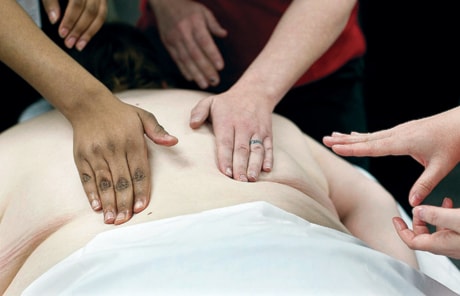Massage can make a difference to people with chronic low back pain when it’s added to their usual medical treatment, new research indicates.
Low back pain is the second most common cause for visits to general practitioners, right after the common cold, experts say, and improvements to treatment could help cut down on disability and absenteeism in the workplace.
In the study, most patients with low back pain who had a one-hour massage once a week for 10 weeks fared better than patients who weren’t randomized to have the massages and continued to receive regular therapy such as painkillers, muscle relaxants, anti-inflammatory drugs and physiotherapy.
About two-thirds of those receiving massage reported they had improved substantially by the end of 10 weeks, compared with about one-third of those in the usual-care group, according to the research published Monday in the Annals of Internal Medicine.
“I’d say that if you have a persisting back problem that’s been evaluated by a physician and the treatments that you’ve tried haven’t really helped or haven’t helped enough, then trying massage is a reasonable option,” lead author Daniel Cherkin, director of the Group Health Research Institute in Seattle, said in an interview.
The trial involved 401 patients, aged 20 to 65, with chronic low back pain. It looked at both ordinary relaxation massage — the most commonly taught Swedish massage technique — as well as the focused structural kind of massage provided by therapists with more advanced training, Cherkin said.
At the end of 10 weeks, he said both kinds of massage turned out to be a reasonable treatment option for people who have persistent pain that had not been adequately addressed by other means.
Besides improvement in pain and mobility, subjects reported less use of non-steroidal anti-inflammatory medications after massage.
Benefits began to diminish over time, but were still evident at six months, the trial showed. After a year, the difference between the massage groups and the group receiving usual care was not significant.
Dr. Andrea Furlan, an associate scientist at the Institute for Work & Health in Toronto, said the findings are important because if people with chronic low back pain can feel better quicker, they might be able to resume their roles sooner, which would save money and resources.
“There is a need to conduct some cost-benefit analyses to confirm that,” said Furlan, who was not involved in the study.
But people shouldn’t think that massage alone may resolve all low back pain, because it’s a complex condition that involves psychosocial elements, she explained, noting that the spine needs maintenance, including good posture, regular exercise and adequate rest.
In terms of the study, Furlan said the results could have been somewhat affected by participants’ expectations from the trial.
If they had an expectation that they would get weekly massages — but were not among those randomized to the massage group — there might be a tendency to report any emotional frustration in terms of more pain and more symptoms, she noted.
As for whether massage recipients who reported a benefit were experiencing a placebo effect, she said this study doesn’t answer that question.
However, a previous Canadian study published about six years ago did have a “sham laser group” to control for the placebo effect and found that massage, and massage plus exercise, was better than the sham treatment, Furlan said.
“This gives us some idea that it’s not only a placebo effect,” she said.
“It (massage) might also have some physiological effects — maybe because of relaxation you are providing to the muscles, touching the skin, sending information to the central nervous system, including spinal cord and the brain, and that may cause some liberation of endorphins and substances that are analgesic.”
Although the study adds some high-quality evidence that massage has some benefits for chronic low back pain, she personally is a proponent of active therapies.
“Patients need to take control of their body — they need to learn how to relax their muscles, they need to know how to let the anxiety and stress not to be affecting their muscles,” she said. “And massage is helpful, but I don’t think my patients with chronic low back pain should be doing massage once a week or twice a week for the rest of their life.
“When they are in a crisis, if they have chronic low back pain ... it’s hard for them to keep up with their activities, so do a course of massage, let’s say 10 weeks, but then stop and do their changes in their lifestyle.
“Because I think that’s what will maintain them. It’s not massage for everybody forever.”
